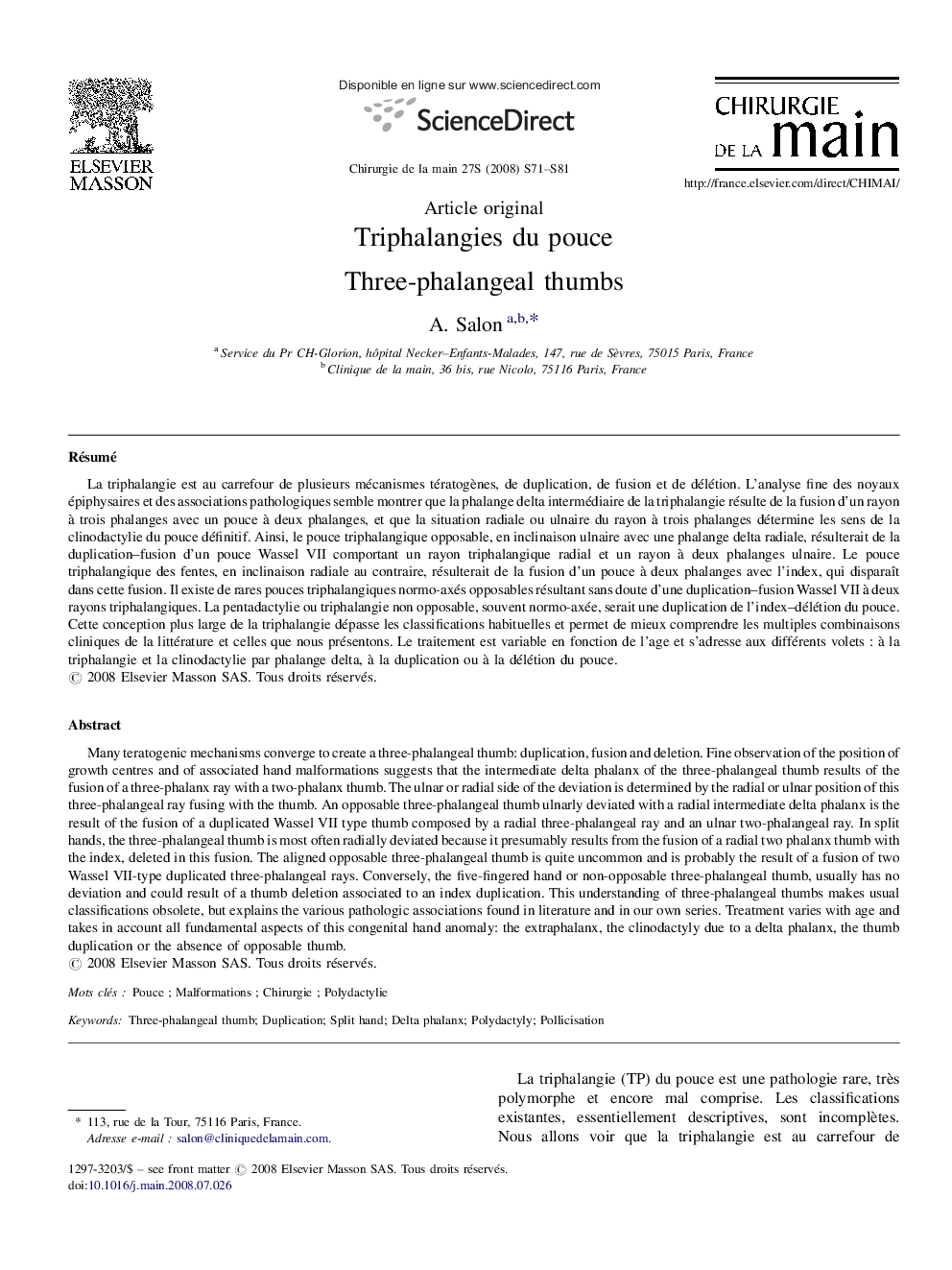| Article ID | Journal | Published Year | Pages | File Type |
|---|---|---|---|---|
| 4049668 | Chirurgie de la Main | 2008 | 11 Pages |
RésuméLa triphalangie est au carrefour de plusieurs mécanismes tératogènes, de duplication, de fusion et de délétion. L’analyse fine des noyaux épiphysaires et des associations pathologiques semble montrer que la phalange delta intermédiaire de la triphalangie résulte de la fusion d’un rayon à trois phalanges avec un pouce à deux phalanges, et que la situation radiale ou ulnaire du rayon à trois phalanges détermine les sens de la clinodactylie du pouce définitif. Ainsi, le pouce triphalangique opposable, en inclinaison ulnaire avec une phalange delta radiale, résulterait de la duplication–fusion d’un pouce Wassel VII comportant un rayon triphalangique radial et un rayon à deux phalanges ulnaire. Le pouce triphalangique des fentes, en inclinaison radiale au contraire, résulterait de la fusion d’un pouce à deux phalanges avec l’index, qui disparaît dans cette fusion. Il existe de rares pouces triphalangiques normo-axés opposables résultant sans doute d’une duplication–fusion Wassel VII à deux rayons triphalangiques. La pentadactylie ou triphalangie non opposable, souvent normo-axée, serait une duplication de l’index–délétion du pouce. Cette conception plus large de la triphalangie dépasse les classifications habituelles et permet de mieux comprendre les multiples combinaisons cliniques de la littérature et celles que nous présentons. Le traitement est variable en fonction de l’age et s’adresse aux différents volets : à la triphalangie et la clinodactylie par phalange delta, à la duplication ou à la délétion du pouce.
Many teratogenic mechanisms converge to create a three-phalangeal thumb: duplication, fusion and deletion. Fine observation of the position of growth centres and of associated hand malformations suggests that the intermediate delta phalanx of the three-phalangeal thumb results of the fusion of a three-phalanx ray with a two-phalanx thumb. The ulnar or radial side of the deviation is determined by the radial or ulnar position of this three-phalangeal ray fusing with the thumb. An opposable three-phalangeal thumb ulnarly deviated with a radial intermediate delta phalanx is the result of the fusion of a duplicated Wassel VII type thumb composed by a radial three-phalangeal ray and an ulnar two-phalangeal ray. In split hands, the three-phalangeal thumb is most often radially deviated because it presumably results from the fusion of a radial two phalanx thumb with the index, deleted in this fusion. The aligned opposable three-phalangeal thumb is quite uncommon and is probably the result of a fusion of two Wassel VII-type duplicated three-phalangeal rays. Conversely, the five-fingered hand or non-opposable three-phalangeal thumb, usually has no deviation and could result of a thumb deletion associated to an index duplication. This understanding of three-phalangeal thumbs makes usual classifications obsolete, but explains the various pathologic associations found in literature and in our own series. Treatment varies with age and takes in account all fundamental aspects of this congenital hand anomaly: the extraphalanx, the clinodactyly due to a delta phalanx, the thumb duplication or the absence of opposable thumb.
